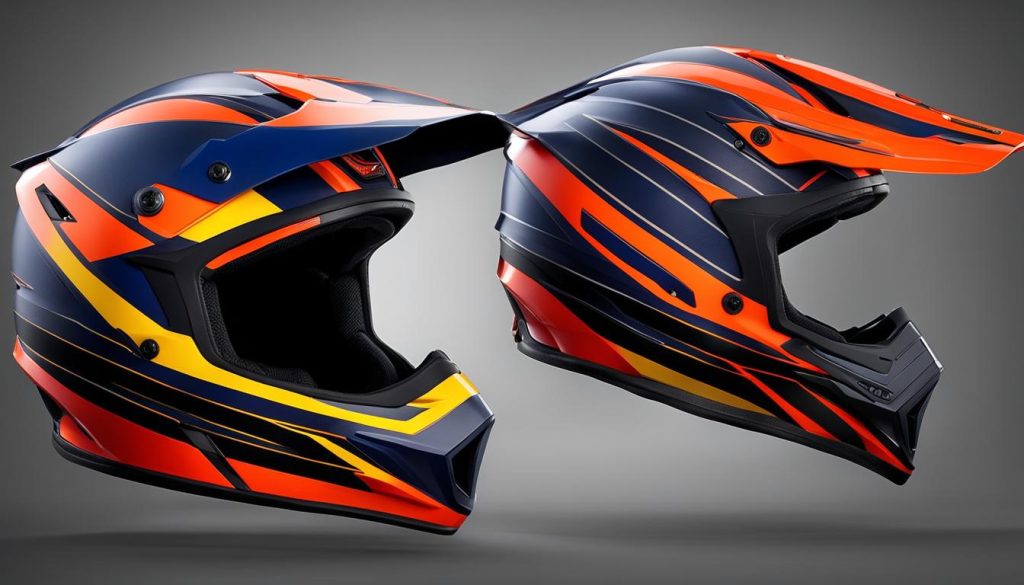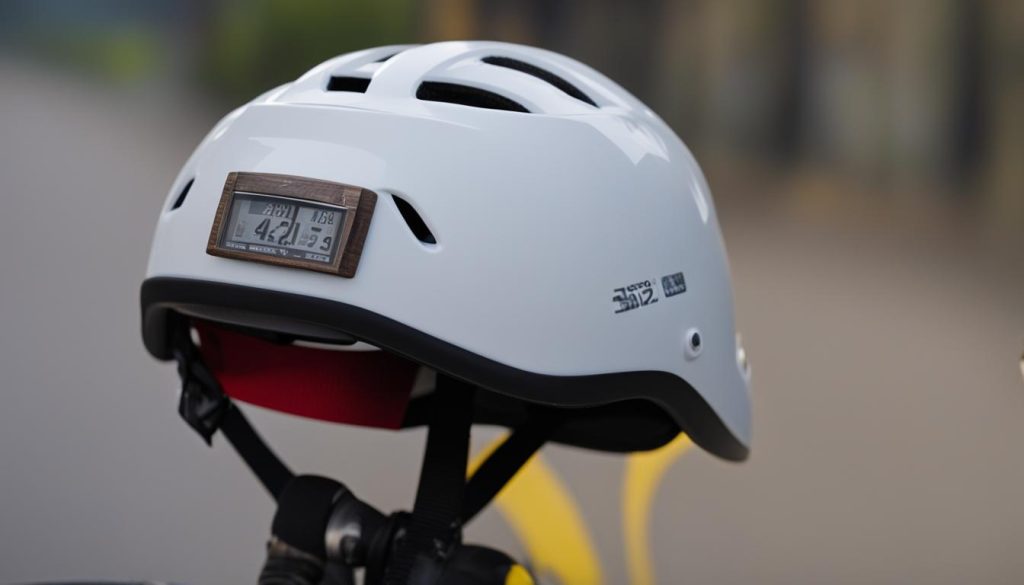When it comes to off-road riding, you need a helmet that is designed specifically for the challenges you’ll face on the dirt track or trail. That’s why it’s important to understand why dirt bike helmets are different from other types of helmets on the market.
Dirt bike helmets are built with unique features, technology, and variations that are designed to meet the unique needs of off-road riding. You won’t find these features on street helmets or other types of helmets.
In this section, we’ll explore these differences and explain why choosing the right dirt bike helmet is crucial for your safety and performance on the dirt.
READ MORE: Bike Safety Essentials: Why Are Bike Helmets Important?
Key Takeaways:
- Dirt bike helmets are specifically designed for off-road riding
- Dirt bike helmets have unique features, technology, and variations
- Choosing the right dirt bike helmet is important for safety and performance
- Street helmets and other types of helmets don’t provide the same level of protection and performance as dirt bike helmets
- Understanding the differences between helmet types can help you make an informed decision
Different Types of Dirt Bike Helmets

When it comes to off-road riding, choosing the right dirt bike helmet can make all the difference. There are several types of dirt bike helmets available in the market, each with its unique construction, design, and safety features.
| Type | Description |
|---|---|
| Full-face helmets | These offer the most protection and coverage, with a chin bar that extends across the face. They’re designed for high-speed riding and provide maximum protection from impacts. |
| Open-face helmets | These helmets have an open face and a chin strap, but no chin bar. They provide good ventilation and visibility, but offer less protection than full-face helmets. |
| Modular or flip-up helmets | These helmets have a chin bar that can be flipped up, allowing for easy communication and convenience. However, they may not be as sturdy as full-face helmets in some cases. |
| Dual-sport helmets | These helmets are designed for both off-road and street use. They have a visor and chin bar for off-road use, but are also DOT-certified for on-road riding. |
When choosing the right dirt bike helmet, it’s essential to consider the type of riding you’ll be doing. Your selection should also meet the necessary safety standards and fit you comfortably to ensure optimal protection during off-road riding.
Safety Standards for Dirt Bike Helmets
If you’re an off-road rider, you know that safety comes first. That’s why dirt bike helmets have to meet specific safety standards to ensure that they will protect you in case of an accident. In this section, we’ll take a closer look at what those safety standards are and how they apply to dirt bike helmets.
Requirements and Certifications
There are several safety standards that dirt bike helmets need to meet. One of the most important is the DOT (Department of Transportation) standard. This certification requires that helmets meet specific impact requirements. Another certification is the Snell Memorial Foundation standard. This nonprofit organization sets even higher standards that some riders prefer. Finally, the ECE (Economic Commission for Europe) standard is a European certification that many manufacturers use to meet safety requirements.
Additional Safety Features
In addition to meeting these safety standards, dirt bike helmets may also have additional features that enhance rider safety. For example, some helmets include MIPS (Multi-directional Impact Protection System) technology that reduces rotational impact forces. Others have emergency quick-release systems that allow first responders to remove the helmet more easily in case of an accident.
“When you’re off-road, safety is essential. That’s why dirt bike helmets have to meet specific safety standards to protect you in case of an accident.”
Conclusion
Now that you have learned about the unique characteristics of dirt bike helmets, it’s important to choose the right one based on your riding style and preferences. Remember, safety should always come first!
By understanding the different types of dirt bike helmets available, their construction and design, as well as the advanced technologies and safety features incorporated into them, you can make an informed decision. It’s important to look for the appropriate safety standards and certifications to ensure optimal protection.
We hope this article has been helpful in guiding you through the process of selecting the right dirt bike helmet for your off-road adventures. Keep in mind the differences in features, variations, and technologies and how they all work together to provide the best protection and performance for your dirt riding needs.
FAQ
Why are dirt bike helmets different from others?
Dirt bike helmets are specifically designed for off-road riding, with features that cater to the unique needs of riders. They have a distinct construction, including a visor to protect against debris and a larger chin bar for additional impact protection. Dirt bike helmets also have increased ventilation to keep the rider cool during intense off-road riding.
What are the different types of dirt bike helmets?
There are several types of dirt bike helmets available, including motocross helmets, enduro helmets, and dual-sport helmets. Motocross helmets are designed for closed-course competition, while enduro helmets are suitable for long-distance riding and varied terrain. Dual-sport helmets are versatile and can be used for both off-road and on-road riding.
How do I choose the right dirt bike helmet?
When choosing a dirt bike helmet, consider factors such as fit, safety certifications, ventilation, and weight. It’s essential to try on different helmet models to ensure a proper fit and consider safety standards like DOT and Snell certifications. Additionally, consider the level of ventilation needed for your riding style and the weight of the helmet for comfort during long rides.
What are the safety standards for dirt bike helmets?
Dirt bike helmets must meet specific safety standards to ensure rider protection. The most common safety certifications for off-road helmets are DOT (Department of Transportation) and Snell (Snell Memorial Foundation). These certifications ensure that the helmet meets the minimum safety requirements for impact protection and penetration resistance.
What features are important in dirt bike helmets?
Dirt bike helmets come with various features to enhance rider safety and performance. These may include adjustable visors, removable and washable liners, quick-release buckles, and integrated goggle straps. Additionally, advanced technologies like MIPS (Multi-directional Impact Protection System) and emergency cheek pad removal systems offer additional safety benefits.
How do off-road helmet variations affect helmet performance?
Off-road helmet variations, such as aerodynamic designs, increased ventilation, and extended chin bars, significantly impact helmet performance. These variations are specifically engineered to provide better airflow, reduce wind resistance, and increase impact protection during off-road riding.
What is the technology used in dirt bike helmets?
Dirt bike helmets incorporate various advanced technologies to enhance safety and comfort. Some notable technologies include MIPS, which reduces rotational forces during impacts, and emergency cheek pad removal systems, which assist in helmet removal in case of an emergency. Additionally, helmet manufacturers use advanced materials and construction techniques for maximum impact absorption and weight reduction.





